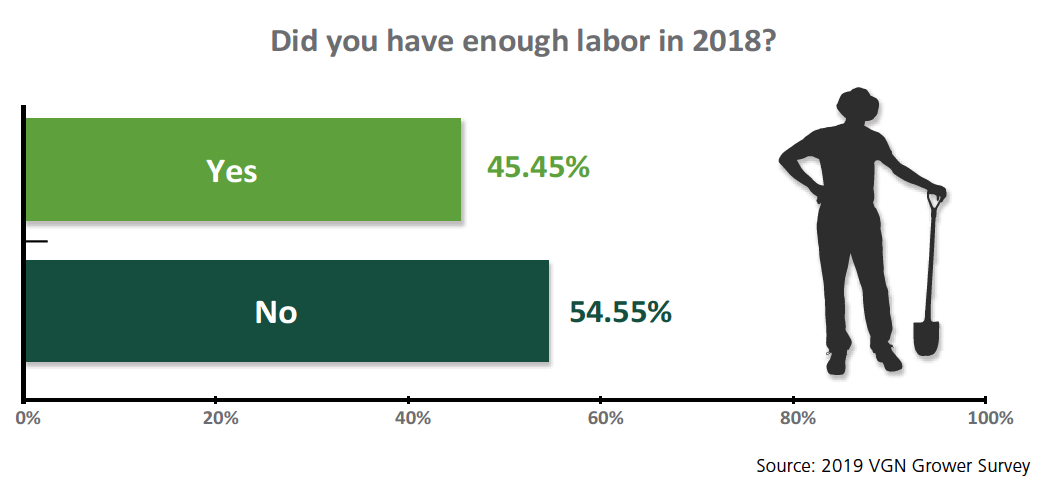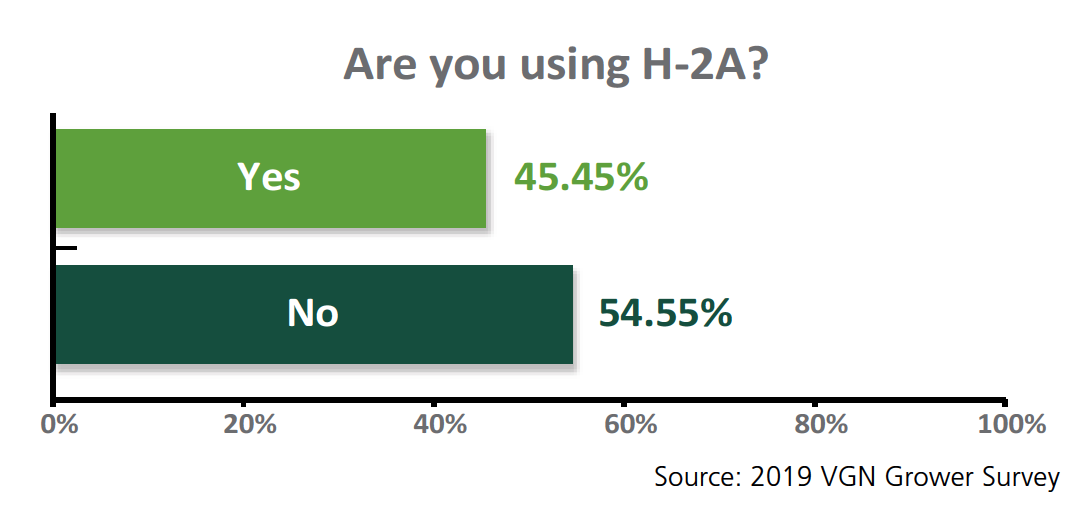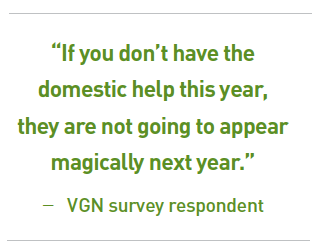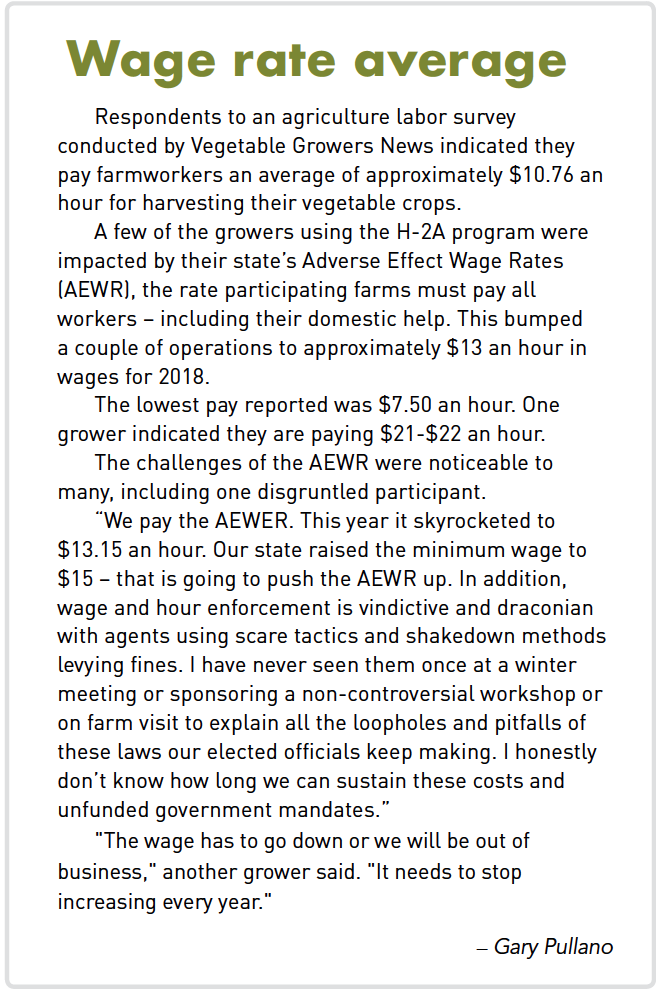

May 29, 2019Survey: Grower search for labor intensifies
For the third consecutive year, the majority of growers who responded to a labor survey conducted by Vegetable Growers News reported they experienced severe worker shortages. Most continue to search for labor solutions, including the H-2A worker visa program to meet their crop production goals.
The survey – conducted in the first quarter of 2019 – asked growers if they had enough labor in 2018. More than 54% indicated they did not have enough adequate worker numbers for the previous season. That percentage was slightly more than the 53% who fell short as found in the 2018 survey results that inquired about 2017 totals.


Just 46% of farm operators had enough labor in 2018, compared to the same amount for 2017, and similar to the 47% found in the survey for 2016.
“Labor is harder to get, and when I do get extra help, I have to pay more,” one farm said of its labor situation. “Prices for my product are way down where
I’m at. When I have to start to harvest, Mexico is still shipping produce into the U.S. at a lower price (that is) very unfair to U.S. growers.”
Some worst-case scenarios came to pass.
“Because of labor shortages and regulations here on Long Island, New York, I was forced to retire from farming,” one respondent said. “I was a fourth-generation and last generation farmer here in my hometown.”
In an effort to have enough help to harvest crops, one grower indicated the farm “chose to forgo hand weeding and other jobs,” while others chose to plant fewer crops.
Respondents who were asked what percentage of workers they lacked from their required worker numbers, showed a range of 0%-95%.
“We just squeezed by and got lucky,” said one respondent.
A total 48% of the respondents indicated that, due to being short of manpower, they were forced to leave crops in the field. As a result, as much as 60% of a crop went unharvested.
While about one-fifth of the respondents indicated they did not have crops that were unharvested due to lack of labor, a number of growers said they took whatever action they could to mitigate the revenue loss.
“We picked crops with the highest value,” one grower said. Some planted crops that “were less labor intensive.”
Another, “slowed down on the packing part and did what we could with the help we had.”
In one instance, a grower acknowledged the need to “plant more mechanical harvesting crops.”
Several growers, including one who “considered closing down,” shared the sentiment of one grower, who, “could not make up – lost it.”
Others fought through, working longer hours, and another “spread the harvesting days on cabbage and zucchini squash. We got more mediums than we should have on squash, but were still able to harvest.”
While survey results once again established a growing trend in the use of H-2A farm visa labor workers, others looked forward to 2019 with other approaches.
“I plan to rip out the orchard and plant only crops that machines can harvest with no labor, such as alfalfa,” one grower said.
Others suggested they would reduce the size of their farm to reduce costs, rely on family members or “hire local college and high school people to help them pay for school.”
Other responses included:
“I will have primarily the same workforce as last year. I am a relatively small fruit producer of blueberries and asparagus.”
“Discontinue CSA (community supported agriculture) program.”
“Using local labor. We have some local labor from Mexico with green cards.”
“Focus on crops that require less labor. Crops that are more labor intensive, focus on harvesting fruit that are most profitable and leave the rest in the field.”
“Try to recruit labor from farms that closed and hire a few guys from Puerto Rico.”
“Advertise more locally for short-term help. We have expanded our crop fields so we will need more help this year.”
“Stay the same. Family-owned and operated. No outside labor.”
“Do only what I can by myself.”
H-2A works – for some


Just 33% of respondents used the program in 2017, with 67% not pursuing that option.
In the 2019 survey results, 45% of respondents said they used H-2A labor in 2018. Last year, the number who did not use the program dipped to 54%.
Growers who use the H-2A system are doing so begrudgingly, according to the survey findings.


“(It’s) cumbersome with paperwork rules – expensive. However, (it’s) the only viable option so we continue to use (it).”
“The only thing I like about it is we can get labor,” another user said. “It is way too expensive and complicated, and the travel expenses and wages are too high. I have also been a victim of unfair Department of Labor investigation that has been going on for five-plus years.”
“(The) pay rate is too high, inspections too difficult, paperwork excessive,” said another in summarizing the sentiment of most H-2A users.
Several respondents mentioned the reliability and commitment of the H-2A laborers, despite one respondent saying “(we) never know what you’re going to get in terms of work ethic.”
“The workers are serious players like years ago,” one grower responded.
“I like knowing I have a workforce. I dislike government over-regulation,” another said.
“It’s a very complicated process with monumental regulations. (We) must hire a service provider to execute.”
“Lots of time, money and general grief over regulations make the H-2A program a tough pill to swallow at times, but the quality of employee has certainly improved over the domestic workforce – if you can find them.”
– Gary Pullano, managing editor
















